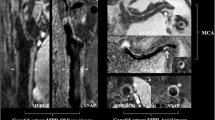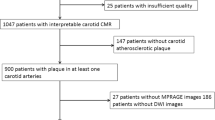Abstract
We previously demonstrated a strong relation between carotid atherosclerosis (defined as carotid artery stenosis ≥50%) and intracranial artery calcification (IAC) in ischemic stroke patients. The purpose of this study was to evaluate the relation between aortic atherosclerosis and IAC. Four hundred fifty-four patients with ischemic stroke were included. Complex aortic plaques (CAP) were assessed by transesophageal echocardiography (TEE) and defined as plaques ≥4 mm thick or with mobile components in the proximal aorta. IAC were assessed in the seven major cerebral arteries and a semiquantitative score system was applied, ranging from 0 (no calcification) to 7. Forty-two patients (9.3%) had CAP. Patients with CAP were older compared with patients without CAP (73.6 vs. 63.6 years, p < 0.001), had more vascular risk factors, more significant carotid artery atherosclerosis (p < 0.001), more chronic kidney disease (p < 0.001), and a higher IAC score (3.0 vs. 1.8; p < 0.001). Stepwise logistic regression selected the following independent factors for CAP: previous stroke or TIA (OR 3.3; 95%CI 1.5–7.0; p = 0.002), carotid artery stenosis ≥50% (OR 3.7; 95%CI 1.7–8.0; p = 0.001), chronic kidney disease (OR 3.8; 95%CI 1.9–7.8; p < 0.001), and IAC score (OR 1.5; 95%CI 1.2–1.9; p = 0.002). IAC was present in 100% of patients with CAP. Moreover, IAC had a high sensitivity (100%) and negative predictive value (100%) for the presence of CAP. In ischemic stroke patients, the absence of IAC strongly points to the lack of CAP. However, these results warrant confirmation in prospective studies before concluding the non-utility of the use of TEE to exclude CAP as a potential source of cerebral embolism in patients without IAC.


Similar content being viewed by others
References
Amarenco P, Duyckaerts C, Tzourio C, Hénin D, Bousser MG, Hauw JJ (1992) The prevalence of ulcerated plaques in the aortic arch in patients with stroke. N Engl J Med 326:221–225
Amarenco P, Cohen A, Tzourio C, Bertrand B, Hommel M, Besson G, Chauvel C, Touboul PJ, Bousser MG (1994) Atherosclerotic disease of the aortic arch and the risk of ischemic stroke. N Engl J Med 331:1474–1479
Hollander M, Hak AE, Koudstaal PJ, Bots ML, Grobbee DE, Hofman A, Witteman JC, Breteler MM (2003) Comparison between measures of atherosclerosis and risk of stroke: the Rotterdam Study. Stroke 34:2367–2373
Kallikazaros IE, Tsioufis CP, Stefanadis CI, Pitsavos CE, Toutouzas PK (2000) Closed relation between carotid and ascending aortic atherosclerosis in cardiac patients. Circulation 102(Suppl):III263–III268
Ruckley CV (1991) Symptomatic and asymptomatic disease. In: Fowkes FGR (ed) Epidemiology of peripheral vascular disease. Springer, London, pp 97–108
Chen X, Lam WW, Ng HK, Fan YH, Wong KS (2007) Intracranial artery calcification: a newly identified risk factor of ischemic stroke. J Neuroimaging 17:300–303
Bugnicourt JM, Chillon JM, Massy ZA, Canaple S, Lamy C, Deramond H, Godefroy O (2009) High prevalence of intracranial artery calcification in CKD patients: a retrospective study. Clin J Am Soc Nephrol 4:284–290
Bugnicourt JM, Chillon JM, Canaple S, Lamy C, Godefroy O (2008) Stroke secondary prevention and blood pressure reduction: an observational study of the use of PROGRESS therapy. Fund Clin Pharmacol 22:217–222
Adams HP Jr, Bendixen BH, Kappelle LJ, Biller J, Love BB, Gordon DL, Marsh EE III (1993) Classification of subtype of acute ischemic stroke. Definitions for use in a multicenter clinical trial. TOAST. Trial of Org 10172 in Acute Stroke Treatment. Stroke 24:35–41
Levey AS, Coresh J, Balk E, Kausz AT, Levin A, Steffes MW, Hogg RJ, Perrone RD, Lau J, Eknoyan G (2003) National Kidney Foundation practice guidelines for chronic kidney disease: evaluation, classification, and stratification. Ann Intern Med 139:137–147
Babiarz LS, Yousem DM, Bilker W, Wasserman BA (2005) Middle cerebral artery infarction: relationship of cavernous carotid artery calcification. Am J Neuroradiol 26:1505–1511
Taoka T, Iwasaki S, Nakagawa H, Sakamoto M, Fukusumi A, Takayama K, Wada T, Myochin K, Hirohashi S, Kichikawa K (2006) Evaluation of arteriosclerotic changes in the intracranial carotid artery using the calcium score obtained on plain cranial computed tomography scan: correlation with angiographic changes and clinical outcome. J Comput Assist Tomogr 30:624–628
Chen XY, Wong KS, Lam WW, Zhao HL, Ng HK (2008) Middle cerebral artery atherosclerosis: histological comparison between plaques associated with and not associated with infarct in a postmortem study. Cerebrovasc Dis 25:74–80
Marzewski DJ, Furlan AJ, St Louis P, Little JR, Modic MT, Williams G (1982) Intracranial internal carotid artery stenosis: longterm prognosis. Stroke 13:821–824
Demopoulos LA, Tunick PA, Bernstein NE, Perez JL, Kronzon I (1995) Protruding atheromas of the aortic arch in symptomatic patients with carotid artery disease. Am Heart J 129:40–44
Tribouilloy C, Peltier M, Rey JL, Ruiz V, Lesbre JP (1998) Absence of atherosclerotic plaque in thoracic aorta by multiplane transesophageal echocardiography: a predictor of absence of significant coronary artery disease in aortic stenosis. Chest 113:671–675
Tunick PA, Rosenzweig BP, Katz ES, Freedberg RS, Perez JL, Kronzon I (1994) High risk for vascular events in patients with protruding aortic atheromas: a prospective study. J Am Coll Cardiol 23:1085–1090
Tribouilloy C, Peltier M, Andrejak M, Rey JL, Lesbre JP (1998) Correlation of thoracic aortic atherosclerosis plaque detected by multiplane transesophageal echocardiography and cardiovascular risk factors. Am J Cardiol 82:1552–1555
Zavala JA, Amarrenco P, Davis SM, Jones EF, Young D, Macleod MR, Horky LL, Donnan GA (2006) Aortic arch atheroma. Int J Stroke 1:74–80
Harloff A, Handke M, Geibel A, Oehm E, Guschlbauer B, Olschewski M, Hetzel A (2005) Do stroke patients with normal carotid arteries require TEE for exclusion of relevant aortic plaques? J Neurol Neurosurg Psychiatry 76:1654–1658
Kawamura M, Fijimoto S, Hisanaga S, Yamamoto Y, Eto T (1998) Incidence, outcome, and risk factors of cerebrovascular events in patients undergoing maintenance hemodialysis. Am J Kidney Dis 31:991–996
London GM (2003) Cardiovascular calcifications in uremic patients: clinical impact on cardiovascular function. J Am Soc Nephrol 14:S305–S309
Seliger SL, Gillen DL, Longstreth WT Jr, Kestenbaum B, Stehman-Breen CO (2003) Elevated risk of stroke among patients with end-stage renal disease. Kidney Int 64:603–609
Maeda N, Sawayama Y, Tatsukawa M, Okada K, Furusyo N, Shigematsu M, Kashiwagi S, Hayashi J (2003) Carotid artery lesions and atherosclerotic risk factors in Japanese hemodialysis patients. Atherosclerosis 169:183–192
Levin A, Singer J, Thompson CR, Ross H, Lewis M (1996) Prevalent left ventricular hypertrophy in the predialysis population: identifying opportunities for intervention. Am J Kidney Dis 27:347–354
Fried LF, Shlipak MG, Crump C, Bleyer AJ, Gottdiener JS, Kronmal RA, Kuller LH, Newman AB (2003) Renal insufficiency as a predictor of cardiovascular outcomes and mortality in elderly individuals. J Am Coll Cardiol 41:1364–1372
Desai MY, Kwon DH, Nair D, Mankad SV, Popovic Z, DeCastro S, Nasser HJ, Patel A, Kuvin J, Pandian NG (2008) Association of aortic atherosclerosis and renal dysfunction. J Am Soc Echocardiogr 21:751–755
Author information
Authors and Affiliations
Corresponding author
Rights and permissions
About this article
Cite this article
Bugnicourt, JM., Chillon, JM., Tribouilloy, C. et al. Relation between intracranial artery calcifications and aortic atherosclerosis in ischemic stroke patients. J Neurol 257, 1338–1343 (2010). https://doi.org/10.1007/s00415-010-5528-1
Received:
Accepted:
Published:
Issue Date:
DOI: https://doi.org/10.1007/s00415-010-5528-1




